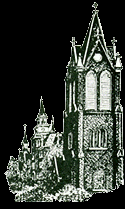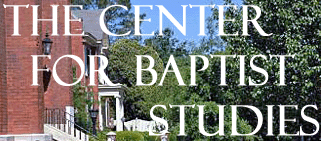|
Encouraging scholarship, strengthening faith identity, and interpreting contemporary issues in Baptist life. |
||
 |
|
Resources: |
|
Home • Staff • Local Church • News & Views • Issues • Bulletin • Conferences / Seminars • Sabbaticals • Certificate • Links |
||
|
Materials Towards A History of the Baptists by Morgan Edwards by Walter B. Shurden Callaway Professor of Christianity Executive Director, The Center for Baptist Studies Mercer University, Macon, Georgia In a previous article I noted that John Clarke, not Roger Williams, was the most influential Baptist in seventeenth-century America. Who then was the most influential Baptist in eighteenth century America? Was it Isaac Backus (1724-1806), the passionate advocate of religious liberty, Massachusetts pastor, and church historian? What about Shubal Stearns (1706-1771)? He was the Separate Baptist evangelistic leader who may be more responsible for the phenomenal growth of Baptists in the South than any other person. Baptist educators would probably want to submit in nomination the name of James Manning (1738-1791). He was the first president of Rhode Island College, the first Baptist college in the country and later to be the prestigious Brown University. Surely, one must handle with caution the opinions of biographers. But one can certainly make a case for the judgment reached by Howard R. Stewart, the biographer of Morgan Edwards (1722-1795), who said, "Morgan Edwards was the outstanding American Baptist leader of the eighteenth century, simply because of being the primary contributor and motivator in more areas of Baptist church life than any other person." My guess is that many who read this will have never heard of Morgan Edwards. So what did he do? Why would someone nominate him for "the outstanding American Baptist leader of the eighteenth century"? A Welshman, Edwards served as pastor of Baptist churches in Ireland and England before coming to this country in 1761 to serve as pastor of the First Baptist Church of Philadelphia, Pennsylvania. In America he became a mover and shaper in the very influential Philadelphia Baptist Association. He wrote the first Baptist church manual in America called Customs of Primitive Churches. Edwards himself deemed his "greatest service" to Baptists of America to be his efforts to help found and endow Rhode Island College. Some historians consider Edwards, not James Manning, to be the primary force behind the establishment of the university. Edwards was also a major figure because he tried to unify, unsuccessfully, the scattered, autonomous Baptist churches in the eighteenth century through Baptist associations. Looking back over Edwards’s life as a whole, however, most historians would probably say that his single most important contribution to Baptists was in his role as a historian. Usually described as the first Baptist historian in America, Morgan Edwards intended to publish a twelve-volume history of the Baptists in America. His design was to compile a history of Baptists in the various colonies. Only two volumes, those on Pennsylvania (1770) and New Jersey (1792), were ever published by Edwards. He completed additional volumes on Delaware and Rhode Island, and they were published in periodicals after his death. Edwards also collected materials "towards" a history of the Baptists in the regions of Maryland, Virginia, North Carolina, South Carolina, and Georgia. Apparently, he also planned volumes on New York, Massachusetts, and maybe Connecticut. But while he did not complete his project, other historians, notably Isaac Backus, John Leland, John Asplund, David Benedict, and all of us since Edwards have benefitted from his extensive and arduous historical labors over three decades. In addition to the published volumes on Pennsylvania, New Jersey, Rhode Island, and Delaware, we fortunately have manuscripts and notebooks of Edwards’s works on Maryland, Virginia, North Carolina, South Carolina, and Georgia. Taken together all of these documents are referred to as "Materials Towards A History of the Baptists." In 1983, Robert G. Gardner, a kind of twentieth-century Morgan Edwards with an Edwards-like passion for detail and accuracy, published an extremely important and relatively unknown book called Baptists of Early America: A Statistical History, 1639-1790. Gardner, reflecting on Edwards’s historical work, described Edwards as an "indefatigable chronicler" of Baptist life whose "data seem usually trustworthy." That is quite a tribute to the eighteenth-century pastor-preacher who faced indescribable difficulties in collecting, preserving, and compiling his "Materials." In a very important preface to the volume on Pennsylvania, Edwards identified his motives for undertaking the formidable task of a twelve-volume history of Baptists in America. First, he, a relatively recent immigrant from Wales and England, wanted "to know the american Baptists." Second, he had "an equal desire to make them known one to another." But, third, his highest motivation was "to unite them together" in a national organization through their associations. Edwards argued that just as individual Baptists should not "abide loose and scattered" but part of local churches, so churches should not remain unrelated to each other. Edwards wanted the churches to be members of regional associations. In turn, he wanted the various associations to be united in the Philadelphia Baptist Association. Edwards’s desire for denominational unity among Baptists in America was and remains a noble one, yet unfulfilled. His proposed organizational scheme could never have worked, however, given the commitment of Baptists to congregational church polity and Edwards’s semi-Presbyterian plan. In this article, I will utilize Edwards’s first volume (Pennsylvania, 1770) as an example of the kind of history he wrote in his other volumes. It is important to note that Edwards was far more interested in compiling historical data than constructing an historical narrative. Making an effort at comprehensiveness, he included among the Baptists almost any group who practiced believers’ baptism. Interestingly, Edwards said that "practicing believer’s-baptism is our denominating article." Did he intentionally omit the mode of baptism as immersion? There is no question that he thought immersion was the proper mode. However, he included in his history some groups who did not immerse. In addition to Baptists with British roots who observed Sunday as the day of worship, he also included several other groups, among them Seventh Day British Baptists who celebrated Saturday as the appropriate day of worship. He even numbered the Keithians, a group of ex-Quakers who adopted believers’ baptism, among the Baptists. Moreover, he identified as Baptists two groups with German roots. One of these, the Dunkers or Tunkers, baptized the candidate by dipping the head in water three times while the candidate was kneeling. Very much like the Quakers, the Dunkers used "plainness of language and dress," and they practiced feet washing, the kiss of charity, and anointing the sick with oil, among other things. The last group Edwards included were the Mennonites, followers of Menno Simons. In many ways, especially in life style, they were akin to the Dunkers. Plain dress, said Edwards, was "so capital a point with them that some have been expelled from their societies for having buckles to their shoes and pocket holes to their coats." They practiced believers’ baptism, but their mode of baptism was affusion or pouring, not immersion. While including both the Dunkers and Mennonites among the Baptists, Edwards said that these were "in a great measure" Baptists "in name rather than fact." Edwards presented his historical data in a rather systematic pattern, compiling his material with an obvious eye on the future history of Baptists. He saw his task primarily as that of collecting the information. Others could attempt to construct artistic histories and offer meaningful interpretations at a later date. Under each separate group of Baptists in each geographical region, Edwards listed the individual churches, provided their historical origins, described the physical characteristics of the buildings, commented on remarkable happenings in the churches, and provided a list of the ministers with biographical data. In some ways, one may consider the "Materials Towards a History of the Baptists" as a denominational genealogy. That is what makes it a classic. Genealogies may be sketchy, ill-constructed, and even boring. But they are priceless to family members interested in their family history. One reads Edwards for interesting and valuable information, not for style or cleverness of interpretation. While much of the "Materials . . . " consists of raw historical data, Edwards throws significant light on Baptist life in the eighteenth century. Let me illustrate with two topics: Baptist associations and Baptist beliefs. First, because Edwards wanted Baptists of America to create denominational union through their associations, he gave some considerable attention to the nature of Baptist associations. In an appendix to his Pennsylvania volume he describes "The Origin, Nature, and Usefulness of the Philadelphia Baptist Association." Sensitive to the priority of the local churches in Baptist life, Edwards described the association only as an "advisory council." It was not an ecclesiastical legislature with jurisdiction or coercive powers "nor anything else which may interfere with the rights of particular churches, or those of private judgment." He described how a few wanted to make the association a court of appeal from the local church. This was soundly rejected. "Nay," said Edwards, "the very word appeal has a caveat upon it in the records, lest the judgment or advice which t he association give upon matters brought before them . . . should be considered as decisive, or the acts of a superior judicature." In another appendix to the Pennsylvania volume Edwards describes how an Episcopalian minister of Philadelphia arrogantly invited the Baptists to return to the Church of England. Edwards includes the sarcastic letter of response written by the Baptists. While it is not a "formal" confession of faith, the letter reveals clearly some of the distinctives of early Baptists. Some of these distinctives were: (1) Christ, not bishops or ecclesiastical courts, is the only Head and Lawgiver of the church; (2) a church should be composed of believers only and not a "mixed multitude"; (3). local congregations, with their ministers or elders, have power and authority to receive persons into membership, to censure, and excommunicate; (4) the Bible says nothing about saying "the confession, lords prayer and creed," nor do people have to respond in worship according to the Book of Common Prayer; (5) the New Testament does not authorize use of musical instruments in public worship; (6) infant baptism is wrong; and (7) sprinkling or pouring are wrong as forms of baptism. Edwards’s enthusiasm for his work of collecting and writing Baptist history could not be concealed. He wanted desperately that "all the baptist churches from Nova Scotia to Georgia be made sufficiently known to one another." He thought that his history would help bring that to fruition. More importantly, however, he hoped that the history would lead to the unification of Baptists in America. Speaking of himself and the aim of his historical work, Edwards said, "As to apologies for the work itself he will not attempt any, being firmly of opinion that if he should lose any reputation by it he cannot lose it in a better way than in endevouring to promote the baptist interest; which in his judgment, in [is] the interest of christ above any in christendom."
|
||
|
The Center for Baptist Studies, Mercer University, 1400 Coleman Avenue, Macon, GA 31207 Phone (478) 301-5457 |
||
